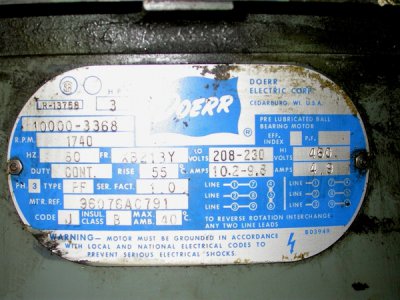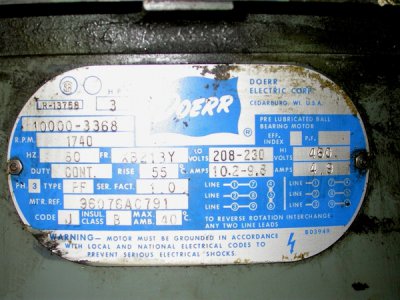- Joined
- Apr 6, 2011
- Messages
- 2,082
I'm coming getting very close to the point where I'm ready to plug my new (to me) mill in but I need to be a little more clear on a couple of things before I go plugging it in and throwing the switch.
To give a bit of background, I just pulled in the 3-phase from my nearby office to my "shop". The power is 3-phase, 4 wire, 208v. Now, that means that (in my case) I have 4 wires coming in to my box and they are marked as black, red, blue, and white. The "white" wire is the neutral/ground and all the white and green wires in the box are connected together. Now, I just changed out the plug on the mill to match my receptacle BUT the mill's power cord also has 4 wires and they are green, white, black, and red. The green in the power cord is grounded to the body of the machine.
Does this mean I should match my white wire (from the box) to the green wire in the power cord and also connect the blue wire (from the box) to the white power cord wire? (Not that there are many options I just want to make absolutely sure of things before I accidentally let the magic smoke escape.)
My next question is about the re-wiring of the motors for 208/220v. I understand the wiring diagrams on the motor plates:

No problems there except for the fact that I have "reverse" switches on both motors, a Cutler-Hammer "9441" on the horizontal and an Allen-Bradley on the vertical. Do I change the wiring between the switches and the motors (my guess) or before the switches and will I also need to figure out how to re-wire the switches in either case?
Thanks guys,
-Ron

To give a bit of background, I just pulled in the 3-phase from my nearby office to my "shop". The power is 3-phase, 4 wire, 208v. Now, that means that (in my case) I have 4 wires coming in to my box and they are marked as black, red, blue, and white. The "white" wire is the neutral/ground and all the white and green wires in the box are connected together. Now, I just changed out the plug on the mill to match my receptacle BUT the mill's power cord also has 4 wires and they are green, white, black, and red. The green in the power cord is grounded to the body of the machine.
Does this mean I should match my white wire (from the box) to the green wire in the power cord and also connect the blue wire (from the box) to the white power cord wire? (Not that there are many options I just want to make absolutely sure of things before I accidentally let the magic smoke escape.)
My next question is about the re-wiring of the motors for 208/220v. I understand the wiring diagrams on the motor plates:

No problems there except for the fact that I have "reverse" switches on both motors, a Cutler-Hammer "9441" on the horizontal and an Allen-Bradley on the vertical. Do I change the wiring between the switches and the motors (my guess) or before the switches and will I also need to figure out how to re-wire the switches in either case?
Thanks guys,
-Ron



 ) On this system, the neutral leg is tied to ground in the panel(s) as it should be. There is also a ground rod through the floor with a bare connector up to the panel that remain intact (I always thought those were in case of lightning strikes. :thinking
) On this system, the neutral leg is tied to ground in the panel(s) as it should be. There is also a ground rod through the floor with a bare connector up to the panel that remain intact (I always thought those were in case of lightning strikes. :thinking